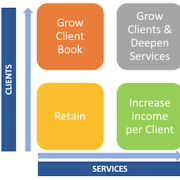Building bridges with the next generation (Part 1)
This is the first instalment in a two-part article about expanding your client base into the next generation of younger clients, by accessing the children of your clients. In this first piece, we consider the challenge of gaining access to the children of clients. Next month we’ll look at how you make this work within your business.
For many established advisers who have been offering financial advice and solutions to their clients for many years, their challenge is that their clients belong to the same generation as themselves. These clients are moving towards retirement age, at which stage they will stop accumulating further assets, and in fact will start de-cumulating, through living off their ARFs and other investments built up during their working lives. And as their assets reduce, so does the remuneration of many advisers whose charges are based solely on asset values.
But an even bigger problem arises when these clients die. In the United States, it is estimated that children do not retain their parent’s adviser in 90% – 95% of cases after their parent’s death. This results in the adviser’s remuneration going immediately to zero. Is the figure likely to be significantly different in Ireland?
This is a shocking figure! Shocking because of the sheer size of the figure, but on the other hand the good news is that there is a lot that you can do to build solid relationships with the adult children of your clients.
Get to know them
First of all, make sure that your client’s children know who you are. Seek permission from your client to introduce yourself to them – not to hound them for business, but simply positioned so that their children have a recognised and friendly face in the event of the death of the parent. Your client will want their finances handled efficiently and as per their instructions. To assist in this, at this stage you are suggesting that their children should know,
- Who you are
- Where and how to contact you
- The broad areas where you are helping their parents (obviously with the parent’s permission).
Should a death occur in the family, at least now you are a friendly face who has some chance of working collaboratively with the children of your deceased client, rather than some faceless organisation that the client doesn’t know, doesn’t trust and will be generally wary of dealing with.
Demonstrate your value from afar
Then when you are introduced to your client’s children, take the relationship very slowly. Look to add value by adding them to your ongoing communications networks, after first of all finding out which communication channels they want you to use. – depending on their preferences, look to add them to your email newsletter, connect with them on LinkedIn, follow them on Twitter etc. If you are hosting a relevant seminar, you should even consider suggesting to your clients that they bring one of their adult children along to it.
Now you have an opportunity to remind these adult children regularly of the value that you add to your clients (and their parents), and how in time you could also add value to them. Carefully chosen messages of the value that you add just might get them to contact you as a financial need arises in their own lives.
Include them (as appropriate) in their parent’s financial plans
This is obviously an area in which you need to tread carefully, but there may well be areas of a parent’s financial planning in which it makes sense to involve their adult children. As parents move towards the later stages of their lives, wealth transfer, estate planning and legacy building tend to become important areas for consideration.
While parents may not want to share every small detail of their financial situation with their children, some planning will make lives easier down the road.
Talk to your clients (and their adult children) about the importance of having a will. Talk all of them through the benefits of putting an enduring power of attorney in place. Build a partnership with a good solicitor who can put these in place for them.
Ensure your clients and their adult children understand the structure and implications of making gifts from a parent to a child and of Capital Acquisitions Tax. Make sure they are aware of the annual exemptions available so that they can avail of these exemptions whenever possible.
At the end of the day, you want the opportunity to demonstrate to the adult children of your clients that you really care about your clients, that their interests are paramount in everything that you do. They will see you a valuable, trusted adviser to their parents. And they will also see that you can carry out the same role for them too. And how you do this last piece will be covered in a follow-up piece next month.







